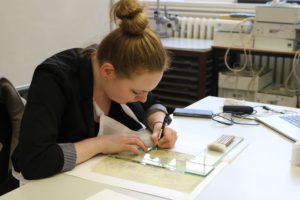Elisabeth Randell: Conserving Transparent Paper
MoDA’s Preventative Conservation Officer, Emma Shaw supports students on the MA Conservation course at Camberwell College of Arts, University of the Arts London, through placements and project work. Recently, Elisabeth Randell completed some conservation work for us as part of her course. She shares her experience here.
I was fortunate enough to work on three transparent papers from the Silver Studio Collection held at the Museum of Domestic Design and Architecture. The focus of this project was to assess, document, research and conserve the three objects.
Before beginning any treatment, it was crucial to understand how transparent papers were produced. Understanding the historical methods of paper production allows conservators to make more informed decisions when devising a strategy for their stabilisation.
The production of transparent paper
The cellulose fibre of paper itself is actually transparent, but the diffusion of light is generated from the air filling the recesses and hollows of the fibres. This scatters the light, causing paper to be seen as opaque. To create a transparent paper, the following three methods are used:
- Impregnation with oils or resins of a similar refraction index to that of the cellulose fibre results in a transparent paper, and is the oldest method of production.
- Mechanical treatment achieves transparency through the expulsion of air by the mechanical action of overbeating the fibres. This causes the cell wall of the cellulose fibre to break down thus minimizing the diffusion of light.
- Chemical treatment uses strong acids and alkaline solutions to swell the fibres and fill in the porous cellulose network of fibres.
All of these methods of production lead to transmission of light through the cellulose fibres which make up the paper, as opposed to the diffusion of light, rendering them transparent.
Context
Next it was important to understand the context of the objects before treating them, and the ethical implications of altering their current state. As these objects were produced in a Studio setting, the smudging and surface dirt could be considered an integral part of the history of the objects. It was ultimately decided, however, that the artistic value of these objects from the Silver Studio Collection and their influence within the design culture were of greater consideration.
This presented interesting challenges as a conservator. On one hand I wanted to maintain the integrity of the artistic design of the individual objects. At the same time I had to consider how not to affect the transparency of the paper through the addition of repair material. It is common practice in paper conservation to use strips of thin Japanese tissue in order to mend tears, using wheat starch paste as the adhesive. This method would have impacted the transparency of the object, and would have to run over the painted or graphite media. In addition, the moisture from the paste would have had negative consequences as transparent papers can distort and cockle with minimal moisture.
A solution to this problem was to use the ‘stitch repair’ technique. This involved pulping Japanese tissue; taking the individual fibres, cut to length (approximately 3mm); pasting them up on a blotter (to absorb excess moisture); and placing the repair in position along the tear. This technique allowed for the repair to be manoeuvred around areas of media, reduced the amount of moisture in contact with the paper, and had minimal effect on the transparency.
This project has pushed me to adapt and to learn new treatment techniques in the process. My experience with transparent papers prior to this project was minimal, making the investigation into the methods of production and ethical considerations when dealing with this type of material extremely validating.
I am grateful to Emma Shaw and the team at MoDA for allowing me to work on such interesting objects from such a culturally significant collection.

